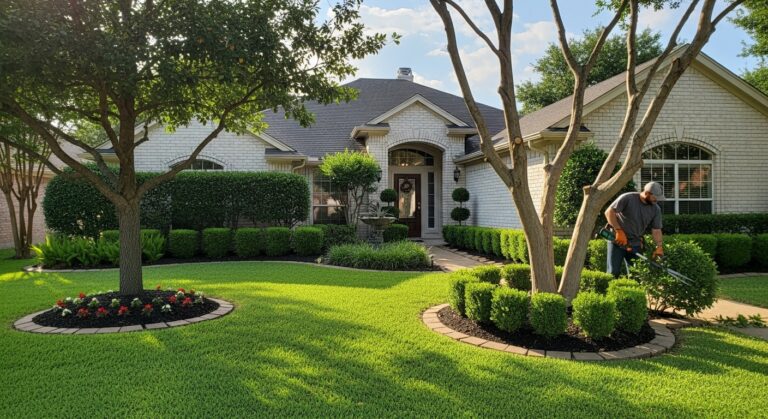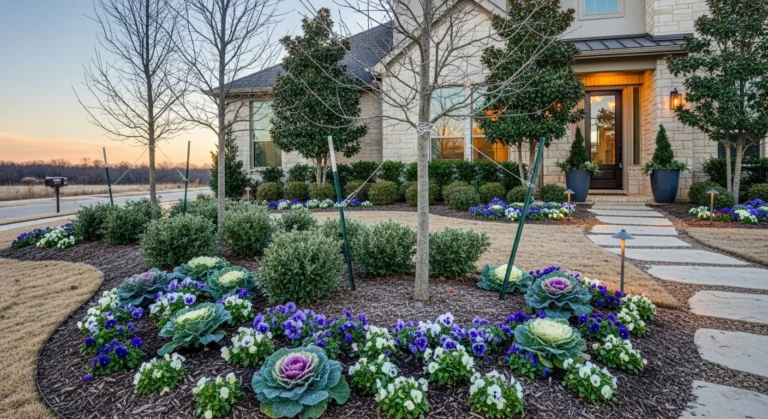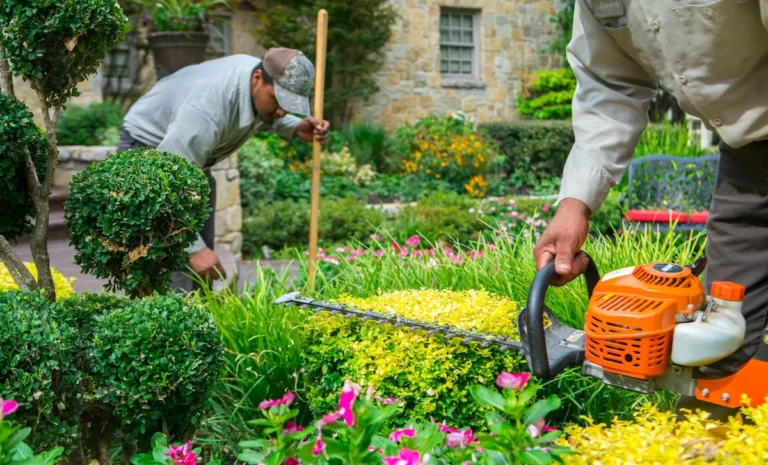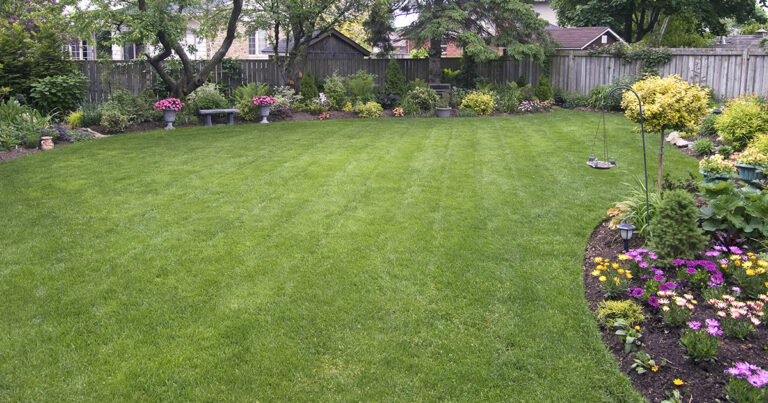Autumn Yard Revival: Your Guide to Fall Landscape
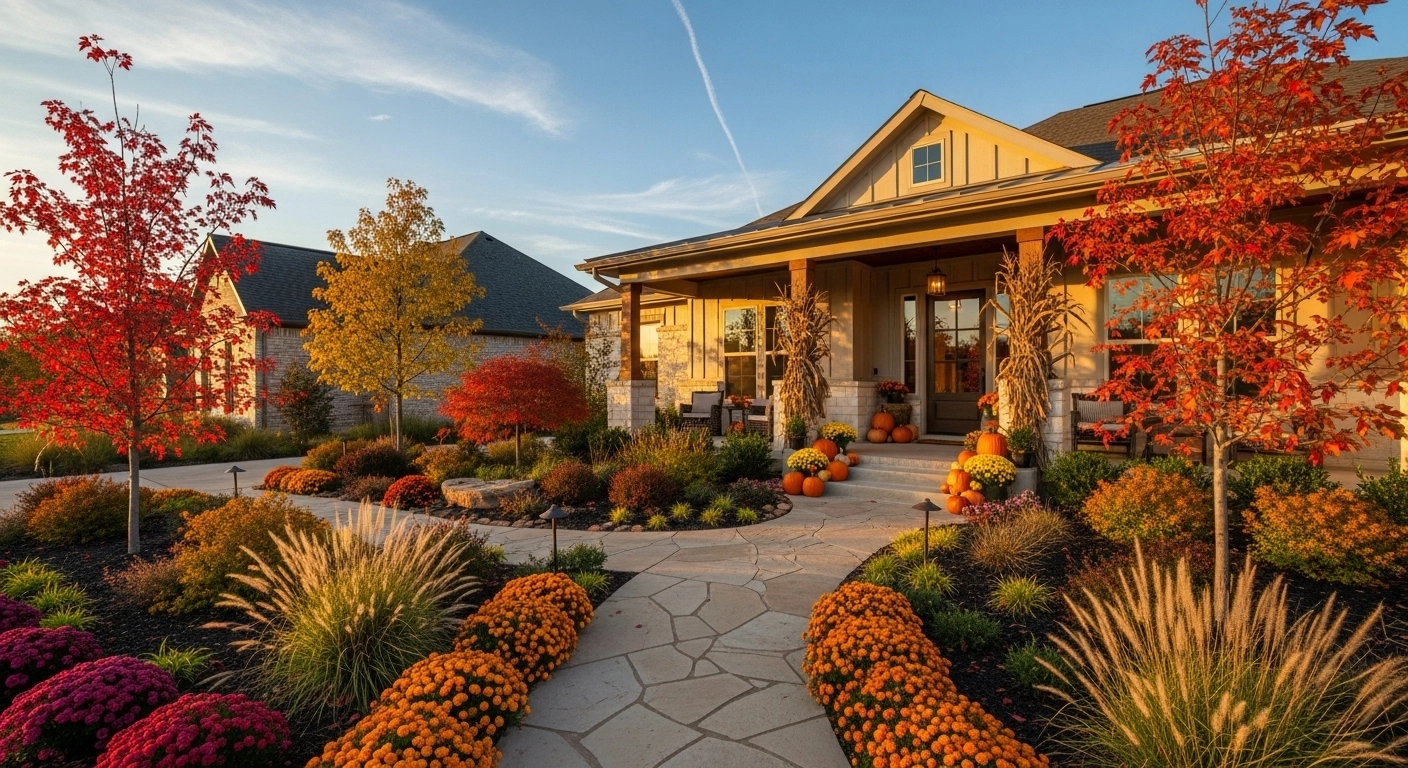
September arrives in Central Texas and you’re finally breathing a sigh of relief that the brutal Summer Landscaping marathon is behind you – except now you’re staring at a landscape that looks like it went ten rounds with Mother Nature and lost every single one. Your once-proud garden beds are sparse and tired, the lawn has more brown patches than green, and everything just looks exhausted from months of surviving rather than thriving. The natural instinct is to put the garden tools away and coast through fall, telling yourself you’ll deal with everything when spring motivation kicks in again. But after spending over 16 years helping Central Texas homeowners transform their outdoor spaces, I can tell you that this “wait and see” approach is exactly why so many people start each growing season already behind the curve, spending their springs frantically trying to repair damage that could have been prevented.
The secret that separates thriving landscapes from struggling ones isn’t about having a green thumb or unlimited budget – it’s about recognizing that fall is your landscape’s most important season, not its least important one. While your neighbors are putting their yards on autopilot until next year, this is when you can turn your summer survivor into next spring’s neighborhood showstopper. Our Lawn Care Waco methodology treats autumn as the foundation season where recovery meets preparation, creating the perfect storm of conditions for landscape success. The cooler temperatures, improved moisture conditions, and natural plant rhythms give you a narrow but powerful window to repair, strengthen, and position your outdoor space for incredible results. By the time winter settles in, you’ll be looking at a landscape that’s not just ready to survive the cold months, but positioned to explode with health and beauty when growing season returns.
The Hidden Power of Fall Landscape Investment
Fall landscape work delivers the highest return on investment of any season – it’s like buying landscape success at wholesale prices while your neighbors pay retail come spring. Most homeowners concentrate their efforts and budgets on spring tasks, fighting against natural plant cycles and competing with everyone else for materials and services. Fall work lets you collaborate with nature’s timing instead of battling against it, and plants respond dramatically better to care during their natural preparation phase.
The financial mathematics of fall preparation are compelling. Over the years, we’ve documented that families investing in comprehensive autumn landscape care spend approximately 50% less on spring recovery efforts, plant replacements, and emergency treatments. This isn’t just theoretical savings – it’s real money that stays in your account instead of going toward fixing preventable winter damage and spring failures.
Our Seasonal Landscape tracking data demonstrates that well-prepared landscapes emerge from winter 70% stronger and reach peak appearance 4-6 weeks earlier than those that simply endured the cold season. The difference comes from understanding that autumn isn’t your landscape’s conclusion – it’s the strategic setup that determines everything that follows.
Fall also provides ideal working conditions that don’t exist during other seasons. Moderate temperatures make outdoor work pleasant, plants aren’t stressed by extreme heat, and there’s typically enough soil moisture to make planting and transplanting actually successful. This window won’t last forever, making it even more valuable for homeowners who want to work smarter instead of harder.
Strategic Fall Tasks for Central Texas Success
Turf Recovery and Winterization
Your lawn has been through a war this summer, but fall represents its comeback tour. Cooler nights signal cool-season grasses to resume active growth, while warm-season varieties shift into energy storage mode for winter survival. This transition period offers your best opportunity to repair heat damage, address thin areas, and prepare your turf for healthy spring emergence.
Begin with a comprehensive damage assessment by walking your entire lawn area and cataloging summer’s impact. Note areas with sparse grass coverage, soil compaction from foot traffic, accumulated dead material, and spots where weeds have gained territory. These issues won’t self-correct over winter – they typically worsen, giving aggressive weeds perfect opportunities to dominate weak areas come spring.
Your autumn turf restoration plan:
- Overseed bare and thin areas with climate-appropriate varieties while soil temperatures remain favorable for germination
- Apply fall-specific fertilization emphasizing root development and winter hardiness rather than rapid top growth
- Address soil compaction through core aeration to improve water infiltration and root penetration
- Maintain consistent watering through autumn – many homeowners quit too early, leaving grass vulnerable to winter stress
Timing is everything with fall overseeding in our Central Texas climate. You need soil warm enough for seed germination (typically through mid-November) but air temperatures cool enough that emerging grass isn’t immediately heat-stressed. This window closes quickly, making early action essential for success.
Comprehensive Plant Health Evaluation
Autumn serves as your annual plant health inspection season – the opportunity to identify and address stress, damage, or decline before winter compounds these problems. After surviving Central Texas summer extremes, many plants exhibit symptoms that require attention before cold weather makes intervention more difficult or impossible.
Conduct systematic landscape walks focusing on overall plant health, structural integrity, and preparation needs. Look for pest populations that built up during summer months, disease symptoms that can spread during humid fall weather, and physical damage that could become hazardous during winter storms. Early identification and treatment prevent minor issues from becoming major expenses.
Focus your plant evaluation on:
- Stress recovery support through deep watering and gentle care for plants showing summer damage
- Pest management targeting scale insects, spider mites, and other problems before they overwinter in your landscape
- Selective pruning of dead or damaged material only – save major shaping for full dormancy periods
- Winter protection planning for marginally hardy plants that may need assistance surviving cold snaps
Resist the urge for major pruning projects just because temperatures have cooled. Many plants continue active growth well into fall, and aggressive pruning can trigger new growth that won’t mature before freezing weather. Focus on safety and health issues while leaving aesthetic shaping for proper dormancy timing.
Soil Enhancement and Foundation Building
Fall represents the optimal season for soil improvement because you can implement changes without immediately stressing actively growing plants. Soil remains workable after summer heat while staying warm enough for organic amendments to begin breaking down and integrating before winter freezing. This timing allows months for improvements to establish before spring growing demands peak soil performance.
Current soil testing should be your starting point – summer’s extreme conditions have altered nutrient levels, changed pH balance, and depleted organic matter reserves. Accurate soil analysis provides the roadmap for targeted improvements rather than guesswork that wastes both time and money. Professional testing through Texas A&M AgriLife Extension delivers comprehensive results worth the modest investment.
Your fall soil enhancement strategy:
- Incorporate organic amendments like compost or aged manure to improve soil structure and nutrient retention
- Correct pH imbalances discovered through testing – lime applications need months to effectively change soil chemistry
- Install slow-release nutrition that will break down gradually and be available when spring growth begins
- Address drainage problems in areas where water collection creates ongoing issues
The advantage of fall soil work lies in having months for changes to integrate naturally before plants depend on improved conditions. Organic matter has time to decompose properly, pH adjusters have time to work effectively, and beneficial soil microorganisms have time to establish before growing season demands begin.
Garden Bed Renovation and Cleanup
Garden maintenance extends far beyond simple aesthetics – it’s about eliminating disease reservoirs, pest hideouts, and weed seed sources that can sabotage next year’s growing success. Proper fall cleanup removes problems before they can establish and multiply over winter months.
Remove all diseased plant debris from landscape areas and dispose of it properly in trash collection, never in compost systems. Many plant diseases survive winter in fallen leaves, dead stems, and accumulated debris, ready to reinfect your plants when favorable conditions return. This includes cleaning up fallen fruit, diseased foliage, and any plant material showing signs of bacterial or fungal problems.
Your fall cleanup priorities:
- Clear finished annual crops and flowers that are no longer productive – they’re occupying valuable space and potentially harboring problems
- Selectively cut back perennials that naturally die back, but preserve plants with winter interest or wildlife value
- Manage leaf accumulation in lawn areas and planting beds to prevent matting that blocks light and promotes disease
- Control persistent weeds before they complete their reproductive cycles and scatter seeds for next year’s problems
Balance thorough cleanup with ecological wisdom – some plant material provides valuable winter habitat for beneficial insects and birds while adding visual interest during dormant months. Leave ornamental seed heads, berry-producing plants, and structural elements that enhance rather than detract from winter landscapes.
Mastering Fall Timing in Central Texas
Natural signals trump calendar dates when it comes to successful fall landscape management. Plant behavior, soil conditions, and weather patterns provide better timing guidance than arbitrary dates that don’t reflect actual growing conditions. Central Texas fall weather can be notoriously variable, making flexibility and observation essential skills for landscape success.
Monitor soil temperature and plant responses rather than relying solely on air temperature or calendar schedules. When soil consistently measures 65-75°F at 4-inch depth, conditions favor planting and transplanting activities. When plants begin showing dormancy signals – reduced growth rates, color changes, natural die-back – timing becomes right for more intensive preparation work.
Weather pattern awareness becomes crucial during Central Texas fall transitions. We can experience 85-degree days in October followed by sudden freezes in November, making rigid schedules problematic. This unpredictability explains why preparation should begin early while maintaining flexibility for weather-dependent activities.
Our Landscaping Services crews rely on multiple environmental indicators because experience has proven that successful timing requires reading natural signals rather than following predetermined schedules.
Early Autumn Focus (September – Mid October)
September through mid-October provides premium conditions for intensive landscape activities while temperatures remain moderate and plants continue active growth. This represents your window for major establishment projects that require time for root development before winter dormancy begins.
Prioritize high-impact activities including soil testing and improvement, significant planting projects, lawn restoration, and initial cleanup efforts. Plants installed during this period enjoy 6-8 weeks of favorable growing conditions for root establishment, dramatically improving winter survival rates and spring performance potential.
Take advantage of comfortable working temperatures to complete physically demanding projects like bed reconstruction, major cleanup efforts, and infrastructure improvements. Working in 75-degree weather beats scrambling to finish projects during November’s unpredictable temperature swings.
Late Autumn Preparation (Late October – November)
Late October through November shifts focus toward plant protection and final preparation as temperatures become more erratic and plants transition toward dormancy. This period emphasizes protective measures and maintenance activities that support winter survival and spring readiness.
Concentrate protective efforts on mulch application, final nutrition programs, and establishment of winter care routines. Plants are reducing growth activity but still require consistent support to build adequate energy reserves for surviving winter conditions and emerging vigorously in spring.
Weather monitoring intensifies during this period as early freeze threats can rapidly change task priorities. Maintaining flexible scheduling allows protective responses when needed while continuing routine maintenance during favorable weather windows.
Advanced Fall Planting Strategies
Fall installation delivers advantages that spring planting simply cannot match – moderate air temperatures reduce transplant shock, warm soil encourages rapid root development, and (when cooperative) natural precipitation provides consistent moisture without summer’s brutal evaporation rates. Plants established in fall enjoy months of root development before facing their first heat stress test.
Strategic plant selection based on summer performance observations and long-term landscape objectives becomes critical during fall planting windows. Areas that struggled with heat or drought during recent months need replacement with better-adapted varieties proven to handle Central Texas conditions. Prioritize native and adapted species with established track records in our challenging climate.
Your fall planting success framework:
- Install plants 8-10 weeks before hard freeze to ensure adequate root establishment before dormancy
- Select container-grown specimens over bare-root alternatives for superior establishment success rates
- Maintain consistent moisture through fall and winter – newly installed plants require water even during dormant periods
- Use root development stimulants at installation to encourage rapid establishment in cooling soil conditions
Fall planting investment pays compound returns through improved survival rates, faster establishment, and enhanced performance throughout the following growing season. Plants that spend winter developing strong root systems emerge ready for vigorous growth rather than struggling with basic survival needs.
Winter Weather Preparation Strategies
Central Texas winters deliver notorious unpredictability – conditions can range from mild January days in the 70s to arctic blasts below 20 degrees, sometimes within the same week. This variability makes weather preparation both challenging and absolutely essential, since plants must be ready for whatever extremes develop.
Implement protective measures proactively rather than waiting for weather emergencies to develop. Identify vulnerable plants now and prepare protection materials before crisis conditions arrive. Tender perennials, recently installed plants, and marginally hardy specimens require special attention before severe weather threatens.
Essential winter protection supplies:
- Freeze protection fabric (avoid plastic materials) for covering sensitive plants during extreme cold events
- Insulating mulch materials for protecting root zones and plant crowns from temperature fluctuations
- Tree protection wraps for safeguarding bark of young or sensitive trees from sun scald and freeze injury
- Wind barrier materials for shielding exposed areas from desiccating winter winds
Preparation beats reaction when it comes to weather protection. Having systems ready and materials accessible enables quick response when extreme conditions threaten your landscape investments.
Avoiding Costly Fall Management Errors
Premature maintenance cessation represents the most expensive mistake Central Texas homeowners make each autumn. The reasoning seems logical – cooler weather reduces plant stress, so care requirements must decrease accordingly. However, plants work intensively during fall to prepare for winter survival, requiring consistent support throughout this critical transition.
Early fall over-pruning can stimulate inappropriate new growth that lacks sufficient time to mature before freezing weather arrives. This tender growth becomes extremely vulnerable to cold damage and can actually kill plants that would otherwise survive winter successfully. Reserve major pruning for full dormancy when plants won’t respond with vulnerable new growth.
Late-season fertilization creates similar problems by encouraging growth when plants should focus on dormancy preparation. Final fertilizer applications must be timed to support root development and energy storage without stimulating freeze-vulnerable top growth that compromises winter survival.
Neglecting newly established plants through fall and winter months kills more landscape investments than summer heat stress. These plants lack the extensive root systems necessary for survival without consistent care. Regular watering, weather protection, and health monitoring remain critical throughout their first winter period.
Assuming dormant plants require no water leads to winter desiccation damage that often doesn’t appear until spring growth attempts begin. Evergreen plants particularly continue losing moisture through foliage all winter and need periodic irrigation during extended dry periods to prevent serious stress damage.
Building Momentum for Next Season
Fall preparation creates compound benefits that extend far beyond simple winter survival – it’s about establishing momentum for the most successful growing season you’ve experienced. Every autumn task completed reduces spring workload while building landscape resilience and beauty potential.
Document seasonal lessons learned while experiences remain fresh and actionable. Which plants excelled in their locations? Which areas required constant intervention? What recurring problems dominated your maintenance time? This information becomes invaluable for making informed decisions about next season’s improvements and maintenance focus areas.
Plan your Spring Yard activities now while you have thinking time rather than reacting to immediate pressures. Research plant varieties for spring installation, identify solutions for problematic areas, and develop realistic project timelines that build systematically on the foundation you’re establishing this fall.
Consistently beautiful landscapes don’t result from unlimited budgets or exceptional natural talent – they’re created by homeowners who understand that each season builds strategically on previous efforts, developing continuous improvement cycles rather than perpetual crisis management patterns.


